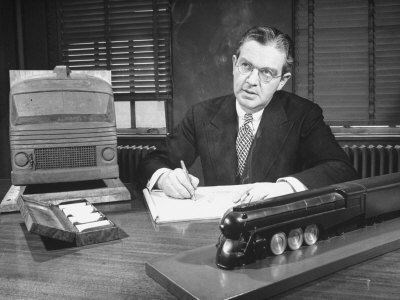Name Henry Dreyfuss | Role Industrial designer | |
 | ||
Artwork Thermos carafe, Slotted spoon, Tray, Potato masher Books Designing for people, Symbol Sourcebook: An Author, The Measure of Man: Hu | ||
Henry dreyfuss the great industrial designer
Henry Dreyfuss (; March 2, 1904 – October 5, 1972) was an American industrial designer. Dreyfuss and his firm received worldwide recognition for numerous designs for a wide spectrum of consumer and commercial products, including their long-time association with the Western Electric company and the Bell System for designing telephones from the 1930s through the 1960s. His design philosophy was based on applied common sense and scientific principles and resulted in significant contributions to human factor analysis and consumer research.
Contents

Henry dreyfuss
Career

Dreyfuss was a native of Brooklyn, New York. As one of the celebrity industrial designers of the 1930s and 1940s, Dreyfuss dramatically improved the look, feel, and usability of dozens of consumer products. As opposed to Raymond Loewy and other contemporaries, Dreyfuss was not a stylist: he applied common sense and a scientific approach to design problems. His work both popularized the field for public consumption, and made significant contributions to the underlying fields of ergonomics, anthropometrics and human factors. Until 1920 Dreyfuss studied as an apprentice to theatrical designer Norman Bel Geddes, his later competitor, and opened his own office in 1929 for theatrical and industrial design activities. It was an immediate and long-lasting commercial success. As of 2005 his firm continues to operate as Henry Dreyfuss Associates in Ann Arbor, Michigan, with corporate clients.
Designs

Dreyfuss and his associates designed some of the most ubiquitous and iconic products of twentieth century America. Among them:

Later life
In 1955, Dreyfuss wrote Designing for People. A window into Dreyfuss's career as an industrial designer, the book illustrated his ethical and aesthetic principles, included design case studies, many anecdotes, and an explanation of his "Joe" and "Josephine" anthropometric charts. In 1960 he published The Measure of Man, a collection of ergonomic reference charts providing designers precise specifications for product designs. In 1965, Dreyfuss became the first President of the Industrial Designers Society of America (IDSA). In 1969, Dreyfuss retired from the firm he founded, but continued serving many of the companies he worked with as board member and consultant. In 1972 Dreyfuss published The Symbol Sourcebook, A Comprehensive Guide to International Graphic Symbols. This visual database of over 20,000 symbols continues to provide a standard for industrial designers around the world.
Death
On October 5, 1972, Dreyfuss and his terminally ill wife Doris Marks Dreyfuss were found in their garage after suicide, dead from intentional carbon monoxide poisoning. Dreyfuss was survived by a son and two daughters.
